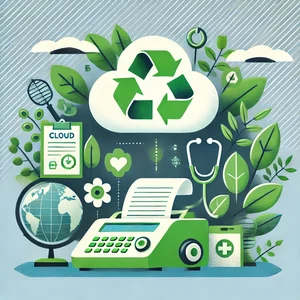 In an era where environmental consciousness is becoming increasingly critical, healthcare organizations are under pressure to adopt more sustainable practices. While many efforts focus on reducing energy consumption, waste, and carbon emissions, one area often overlooked is faxing. Traditional faxing methods, still prevalent in many healthcare settings, can have a significant environmental impact. From excessive paper use to energy-intensive machines, the cumulative effect of traditional faxing is far from green. However, by transitioning to cloud-based faxing solutions, healthcare providers can drastically reduce their environmental footprint while also enhancing efficiency and compliance.
In an era where environmental consciousness is becoming increasingly critical, healthcare organizations are under pressure to adopt more sustainable practices. While many efforts focus on reducing energy consumption, waste, and carbon emissions, one area often overlooked is faxing. Traditional faxing methods, still prevalent in many healthcare settings, can have a significant environmental impact. From excessive paper use to energy-intensive machines, the cumulative effect of traditional faxing is far from green. However, by transitioning to cloud-based faxing solutions, healthcare providers can drastically reduce their environmental footprint while also enhancing efficiency and compliance.
The Environmental Toll of Traditional Faxing
Traditional faxing has been a staple in healthcare for decades, but its environmental costs are substantial:
- Paper Consumption: The healthcare industry is a major consumer of paper, with faxing contributing significantly to this usage. Each fax transmission requires at least one sheet of paper, and given the high volume of fax communications in healthcare, the paper waste can quickly add up. This not only leads to deforestation but also contributes to the waste management burden.
- Energy Usage: Fax machines are notorious for their energy consumption. Many machines are left on 24/7 to ensure they are ready to receive faxes at any time, leading to continuous energy use. This constant draw on electricity, especially when multiplied across thousands of machines in hospitals and clinics, results in a considerable environmental impact.
- Waste Generation: The lifecycle of a traditional fax machine—from manufacturing to eventual disposal—contributes to environmental degradation. Old machines often end up in landfills, where they contribute to electronic waste, releasing harmful chemicals into the environment.
The Case for Cloud-Based Faxing
Cloud-based faxing offers a greener alternative, addressing the environmental concerns associated with traditional faxing:
- Reduction in Paper Use: Cloud faxing eliminates the need for physical paper in most cases. Faxes are sent and received digitally, reducing the demand for paper and the associated deforestation. When printing is necessary, healthcare providers can opt to print only essential documents, further minimizing paper waste.
- Lower Energy Consumption: Without the need for physical fax machines, cloud faxing significantly reduces energy consumption. Servers hosting cloud fax services are typically more energy-efficient and are often powered by renewable energy sources, leading to a smaller carbon footprint.
- Decreased Waste: By moving to cloud-based solutions, healthcare organizations can reduce their reliance on physical machines, thereby cutting down on electronic waste. The digital nature of cloud faxing also means fewer resources are used in the production, maintenance, and disposal of fax machines.
Implementing Sustainable Faxing Practices
Healthcare organizations can take several steps to make their faxing processes more sustainable:
- Transition to Cloud Faxing: The most impactful step is to transition from traditional fax machines to cloud-based faxing solutions. This move not only reduces environmental impact but also enhances security, compliance, and efficiency.
- Educate Staff: Ensure that all staff members understand the environmental benefits of cloud faxing and are trained to use the system efficiently. Encourage a paperless mindset where digital records are prioritized over printed documents.
- Set Sustainability Goals: Incorporate faxing into broader sustainability goals within the organization. Track paper and energy usage related to faxing, and set targets for reduction.
- Partner with Eco-Friendly Providers: Choose cloud fax providers, such as WestFax, that prioritize sustainability in their operations. Look for companies that use energy-efficient data centers and have policies in place to reduce their environmental impact.
The Long-Term Benefits
Beyond the immediate environmental benefits, adopting sustainable faxing practices offers long-term advantages for healthcare organizations:
- Cost Savings: Reducing paper use and energy consumption directly translates to cost savings. Over time, these savings can be substantial, especially in large healthcare facilities with high faxing volumes.
- Enhanced Compliance: Cloud faxing is not only environmentally friendly but also helps organizations stay compliant with regulations such as HIPAA, as these solutions often come with advanced security features.
- Improved Public Image: In a world where consumers and patients are increasingly valuing sustainability, adopting green practices can enhance an organization’s reputation. Demonstrating a commitment to the environment can build trust and loyalty among patients and stakeholders.
The environmental impact of traditional faxing in healthcare is significant, but it doesn’t have to be. By transitioning to cloud-based faxing solutions, healthcare organizations can take a major step toward sustainability. This move not only aligns with global efforts to reduce carbon footprints but also brings numerous operational benefits. As the healthcare industry continues to evolve, embracing sustainable practices in all areas, including faxing, will be crucial for creating a healthier planet and a more efficient healthcare system.
